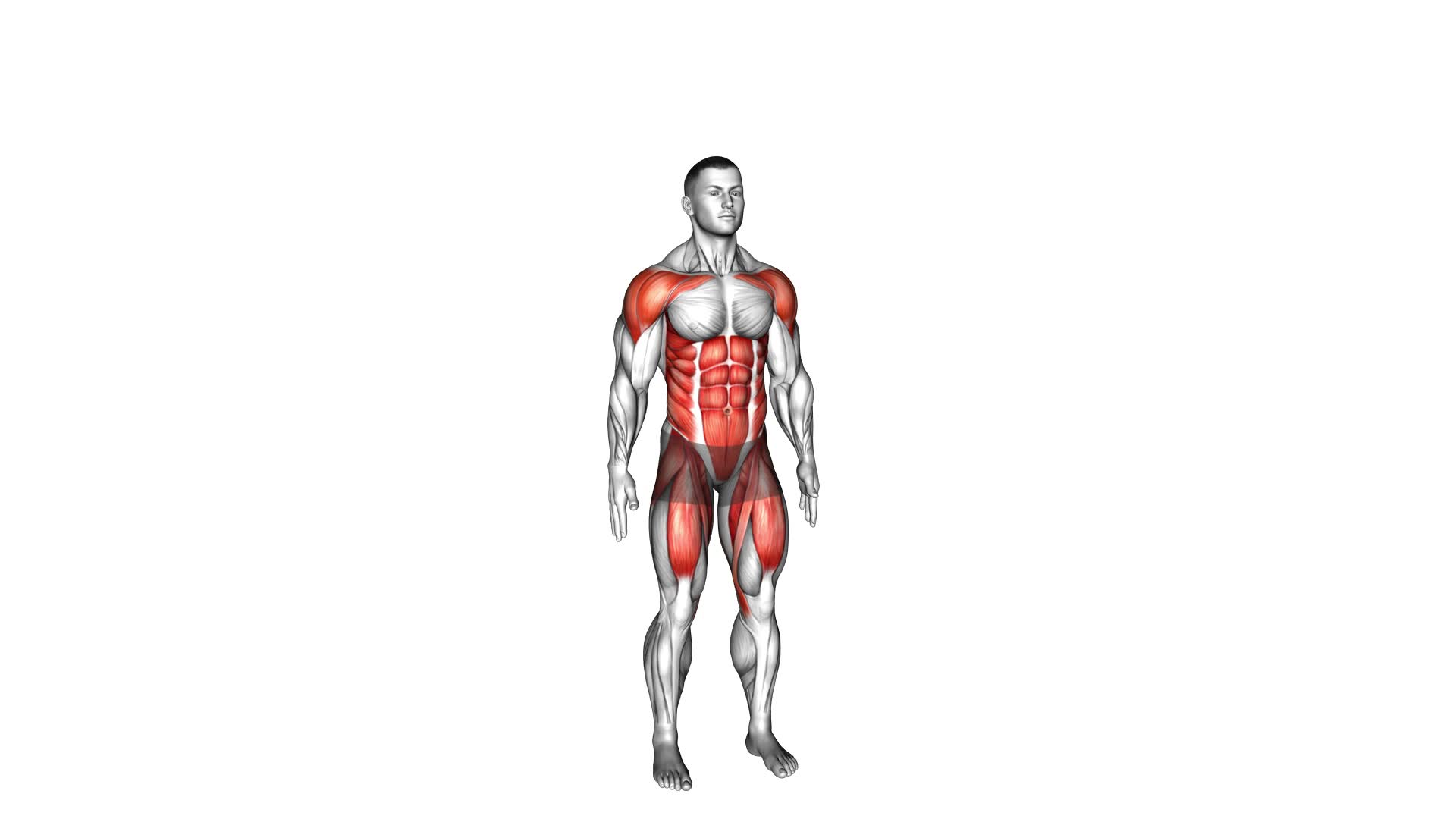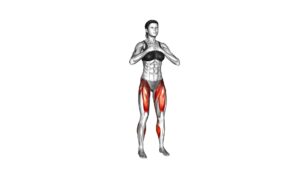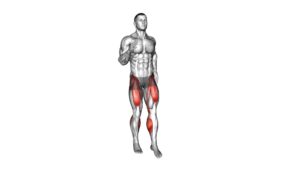Leg Front Kick – Video Exercise Guide & Tips

Looking to improve your leg front kick? Check out this video exercise guide and get ready to take your technique to the next level.
Watch This Exercise Video
In this article, we'll show you the proper form, common mistakes to avoid, and essential drills to enhance your leg front kick.
Whether you're a beginner or an advanced practitioner, these tips and variations will help you incorporate the leg front kick into your training routine effectively.
Let's kick it up a notch!
Key Takeaways
- Targets multiple muscle groups in the legs, including quadriceps, hamstrings, and glutes
- Enhances balance and stability
- Improves coordination and body awareness
- Proper technique involves standing with feet shoulder-width apart, shifting weight onto the back leg, raising the front knee, extending the leg in a swift and controlled motion, striking with the ball of the foot, engaging the core, and keeping the upper body stable.
Benefits of the Leg Front Kick
To maximize your workout, the leg front kick offers numerous benefits for strengthening your lower body and improving overall flexibility. This dynamic movement targets multiple muscle groups in your legs, including the quadriceps, hamstrings, and glutes. By consistently incorporating leg front kicks into your exercise routine, you can build stronger and more toned legs.
One of the key benefits of the leg front kick is its ability to enhance your balance and stability. As you perform the movement, you engage your core muscles to maintain control and prevent yourself from falling over. This not only strengthens your core but also improves your overall coordination and body awareness.
Additionally, the leg front kick can help improve your technique in other exercises, such as kicks and jumps. The repetitive nature of the movement allows you to develop better control and precision in your leg movements. This can be particularly beneficial for athletes involved in sports that require explosive leg power, such as martial arts or dance.
Proper Technique for the Leg Front Kick
To perform the leg front kick with proper technique, you need to focus on your balance and engage the necessary muscle groups. The leg front kick is a versatile and effective move that can be used in various martial arts disciplines, such as karate, taekwondo, and kickboxing. It requires coordination, power, and flexibility.
To start, stand with your feet shoulder-width apart and your hands up to protect your face. Shift your weight onto your back leg and raise your front knee. Extend your leg in a swift and controlled motion, aiming to strike with the ball of your foot. Remember to keep your core engaged and your upper body stable throughout the movement.
There are several variations of the leg front kick that you can incorporate into your training routine. For example, you can perform the kick with a pivot, which adds extra power and allows for better rotation. Another variation involves performing the kick while jumping, which challenges your balance and agility.
To improve your leg front kick, it's important to include conditioning exercises in your training regimen. Some effective exercises include squats, lunges, and calf raises to strengthen your lower body muscles. Additionally, practicing your kick against a heavy bag or target pad will help you refine your technique and increase your power.
Common Mistakes to Avoid During the Leg Front Kick
Avoid these common mistakes when performing the leg front kick to ensure proper technique and maximize its effectiveness in your martial arts practice.
- One common mistake to avoid isn't fully extending your leg. It's important to extend your leg fully to generate maximum power and reach your target effectively.
- Another mistake isn't keeping your supporting leg stable. Your supporting leg should remain strong and grounded to provide a solid base for the kick.
- Additionally, avoid leaning back during the kick. Leaning back can throw off your balance and decrease the power of your kick. Instead, maintain an upright posture and engage your core for stability.
- Another mistake to watch out for isn't retracting your leg after the kick. Failing to retract your leg quickly can leave you vulnerable to counterattacks.
- Lastly, avoid neglecting proper foot positioning. Make sure your foot is flexed and your toes are pointing towards your target to maximize power and accuracy.
Essential Drills to Improve Your Leg Front Kick
To enhance your leg front kick technique and improve its effectiveness, incorporate these essential drills into your training routine.
One of the most important drills is practicing the front kick motion without any resistance. Stand in a stable position, lift your leg, and extend it forward while keeping your toes flexed and your knee straight. Focus on generating power from your hip and core muscles. Repeat this motion for several sets, gradually increasing the speed and intensity.
Another beneficial drill is the target practice drill. Set up a target, such as a punching bag or a pad, at chest height. Practice your front kick by aiming for the target and hitting it with the ball of your foot. This drill helps you improve your accuracy and precision.
Additionally, incorporating balance drills into your training can greatly enhance your leg front kick. Practice standing on one leg and lifting the other leg for a few seconds at a time. This will improve your stability and control, allowing you to execute the front kick with more control and power.
Remember to always warm up before performing these drills and to start slow and gradually increase the intensity. By incorporating these drills into your training routine, you'll improve your leg front kick technique and become a more effective martial artist.
Variations and Advanced Techniques for the Leg Front Kick
Now that you've mastered the basics of the leg front kick, it's time to take your skills to the next level with some variations and advanced techniques.
One option is to incorporate a spin kick combo into your repertoire, adding a dynamic and unpredictable element to your attacks.
Another way to challenge yourself is by targeting different heights with your kicks, practicing precision and adaptability.
Lastly, don't forget to focus on improving both the power and speed of your leg front kick, as these factors can greatly enhance its effectiveness in combat situations.
Keep pushing yourself and exploring new ways to refine your technique.
Spin Kick Combo
Start by incorporating spin kick variations and advanced techniques into your leg front kick. The spin kick technique adds power and unpredictability to your strikes, making it an excellent addition to your arsenal.
To develop this technique, practice spinning on the balls of your feet while maintaining balance and control. Once you have mastered the basics, incorporate spin kick training drills into your workouts. These drills involve spinning and kicking targets at different heights, helping you improve your accuracy and timing.
Targeting Different Heights
Level up your leg front kick by honing your targeting skills and mastering variations and advanced techniques for kicking at different heights. To be a well-rounded martial artist, it's crucial to be able to adapt your front kick to various target heights. By practicing kicking at different heights, you can effectively engage opponents at different distances and angles.
When it comes to high front kicks, there are several advantages. A high front kick can target an opponent's head, providing the opportunity for a knockout or disorientation. It can also create distance and keep your opponent at bay, allowing you to control the pace of the fight. Additionally, a high front kick can be an effective tool for intimidation, showing your opponent your dominance and skill.
Power and Speed Improvements
To enhance the power and speed of your leg front kick, incorporate variations and advanced techniques that allow for increased force and velocity.
Power training exercises, such as plyometric exercises and resistance training, can help you build explosive strength in your legs. Plyometric exercises like jump squats and box jumps can improve your leg power, while resistance training with exercises like squats and lunges can increase your overall lower body strength.
Additionally, agility drills can help improve your speed and quickness, which are essential for executing a fast and powerful leg front kick. Incorporating ladder drills, cone drills, and shuttle runs into your training routine can enhance your agility and footwork.
By combining power training and agility drills, you can maximize the force and speed of your leg front kick.
Now, let's move on to the next section and learn some tips for incorporating the leg front kick into your training routine.
Tips for Incorporating the Leg Front Kick Into Your Training Routine
To effectively incorporate the leg front kick into your training routine, regularly practice this powerful technique. The leg front kick isn't only a dynamic self-defense move but also an excellent exercise for improving flexibility and strengthening your leg muscles. By consistently incorporating this kick into your training, you can reap numerous benefits.
Firstly, the leg front kick requires a good range of motion in your hips and legs. By practicing this kick regularly, you can improve your flexibility in these areas, enhancing your overall athletic performance and reducing the risk of injuries. Stretching exercises, such as the butterfly stretch and the standing quad stretch, can further help to improve your flexibility.
Secondly, the leg front kick heavily engages the muscles in your legs, particularly the quadriceps, hamstrings, and hip flexors. These muscles are responsible for generating power and speed in your kicks. By consistently training this kick, you can strengthen these muscles, improving their endurance and explosive power.
To incorporate the leg front kick into your training routine, start by practicing it in a controlled environment, focusing on proper technique and form. Gradually increase the intensity and speed as you become more comfortable and proficient. Additionally, consider incorporating other leg exercises, such as squats and lunges, to further strengthen your leg muscles.
Frequently Asked Questions
How Long Does It Take to Master the Leg Front Kick?
To master the leg front kick, it takes time and practice. Focus on improving your technique by using these tips:
- Work on your leg strength and flexibility.
- Practice proper body alignment.
- Develop a strong core.
Avoid common mistakes like:
- Telegraphing your kick.
- Not using your hips.
- Neglecting speed and power.
Remember, with consistent training and dedication, you'll see progress and mastery of the leg front kick.
Keep pushing yourself!
Can the Leg Front Kick Be Used for Self-Defense Purposes?
In self-defense applications, the leg front kick can be a highly effective move in real-life situations. By utilizing the power and speed of your leg, you can quickly strike an attacker and create distance.
The leg front kick targets vulnerable areas such as the groin, stomach, or even the face, causing significant pain and disorientation. Mastering this technique can provide you with a valuable tool to protect yourself and increase your self-confidence in dangerous situations.
Are There Any Specific Muscles That Are Targeted When Performing the Leg Front Kick?
When you perform the leg front kick, you target specific muscle groups in your body. This powerful kick primarily engages your quadriceps, hamstrings, and hip flexors, helping to strengthen and tone these muscles.
In addition, the leg front kick also engages your core muscles, including your abs and obliques, as well as your glutes and calves.
What Are Some Modifications or Adaptations for Individuals With Limited Range of Motion or Injuries?
If you have limited range of motion or injuries, there are modifications you can make for the leg front kick. These adaptations help individuals with physical limitations.
By adjusting the height and intensity of the kick, you can still benefit from this exercise without causing further harm.
It's important to listen to your body and work within your capabilities. Don't be discouraged – with the right modifications, you can still achieve a great workout!
Can the Leg Front Kick Be Used in Combination With Other Martial Arts Techniques?
When it comes to leg front kick combinations, the possibilities are endless! This powerful move can be seamlessly integrated with other martial arts techniques to create devastating attacks.
Whether you're using punches, elbows, or even knee strikes, the leg front kick adds an extra layer of effectiveness to your combat skills. Its versatility and impact make it a valuable weapon in any fighter's arsenal.
Conclusion
Incorporating the leg front kick into your training routine can provide numerous benefits, including improved strength, flexibility, and coordination.
By following proper technique and avoiding common mistakes, you can maximize the effectiveness of this exercise.
Additionally, incorporating essential drills and advanced techniques can help you further enhance your leg front kick.
So, why wait? Start incorporating this powerful move into your workouts and take your training to the next level.

Author
Years ago, the spark of my life’s passion ignited in my mind the moment I stepped into the local gym for the first time. The inaugural bead of perspiration, the initial endeavor, the very first surge of endorphins, and a sense of pride that washed over me post-workout marked the beginning of my deep-seated interest in strength sports, fitness, and sports nutrition. This very curiosity blossomed rapidly into a profound fascination, propelling me to earn a Master’s degree in Physical Education from the Academy of Physical Education in Krakow, followed by a Sports Manager diploma from the Jagiellonian University. My journey of growth led me to gain more specialized qualifications, such as being a certified personal trainer with a focus on sports dietetics, a lifeguard, and an instructor for wellness and corrective gymnastics. Theoretical knowledge paired seamlessly with practical experience, reinforcing my belief that the transformation of individuals under my guidance was also a reflection of my personal growth. This belief holds true even today. Each day, I strive to push the boundaries and explore new realms. These realms gently elevate me to greater heights. The unique combination of passion for my field and the continuous quest for growth fuels my drive to break new ground.







